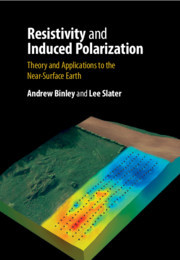Description
Resistivity and Induced Polarization
Theory and Applications to the Near-Surface Earth
Authors: Binley Andrew, Slater Lee
A comprehensive text on resistivity and induced polarization covering theory and practice for the near-surface Earth supported by modelling software.
Language: English
Subject for Resistivity and Induced Polarization:
Approximative price 95.29 €
In Print (Delivery period: 14 days).
Add to cart
Publication date: 12-2020
408 p. · 17.5x25 cm · Hardback
408 p. · 17.5x25 cm · Hardback
Description
/li>Contents
/li>Biography
/li>
Resistivity and induced polarization methods are used for a wide range of near-surface applications, including hydrogeology, civil engineering and archaeology, as well as emerging applications in the agricultural and plant sciences. This comprehensive reference text covers both theory and practice of resistivity and induced polarization methods, demonstrating how to measure, model and interpret data in both the laboratory and the field. Marking the 100 year anniversary of the seminal work of Conrad Schlumberger (1920), the book covers historical development of electrical geophysics, electrical properties of geological materials, instrumentation, acquisition and modelling, and includes case studies that capture applications to societally relevant problems. The book is also supported by a full suite of forward and inverse modelling tools, allowing the reader to apply the techniques to a wide range of applications using digital datasets provided online. This is a valuable reference for graduate students, researchers and practitioners interested in near-surface geophysics.
Preface; Acknowledgements; List of symbols; 1. Introduction; 2. Electrical properties of the near surface Earth; 3. Instrumentation and laboratory measurements; 4. Field configuration and acquisition; 5. Forward and inverse modelling; 6. Case studies; 7. Future developments; Appendix A. Modelling tools; Index.
Andrew Binley is Professor of Hydrogeophysics at Lancaster University. His research focuses on the use of near-surface electrical geophysics for hydrogeological characterization. He is the developer of widely used geoelectrical modelling computer codes. In 2012 he was awarded the Frank Frischknecht Leadership Award for his long-term contributions to the field of near-surface geophysics, and in particular hydrogeophysics. This award is jointly presented by the Society of Exploration Geophysicists (SEG) and the Environmental and Engineering Geophysical Society (EEGS). He was elected Fellow of the American Geophysical Union in 2013 for pioneering work on uncertainty modelling and hydrogeophysics.
Lee Slater is a Distinguished Professor and the Henry Rutgers Professor of Geophysics at Rutgers University, New Jersey. His research focuses on near-surface geophysics and he has performed extensive laboratory and field studies with resistivity and induced polarization. In 2013 he was awarded the Harold B. Mooney Award for long-term contributions in education and professional outreach in near-surface geophysics by the Society of Exploration Geophysicists (SEG) and the Environmental and Engineering Geophysical Society (EEGS). He was elected Fellow of the American Geophysical Union in 2013 for visionary experimentation in near-surface geophysics.
Lee Slater is a Distinguished Professor and the Henry Rutgers Professor of Geophysics at Rutgers University, New Jersey. His research focuses on near-surface geophysics and he has performed extensive laboratory and field studies with resistivity and induced polarization. In 2013 he was awarded the Harold B. Mooney Award for long-term contributions in education and professional outreach in near-surface geophysics by the Society of Exploration Geophysicists (SEG) and the Environmental and Engineering Geophysical Society (EEGS). He was elected Fellow of the American Geophysical Union in 2013 for visionary experimentation in near-surface geophysics.
© 2024 LAVOISIER S.A.S.
These books may interest you

Near-Surface Applied Geophysics 83.43 €



